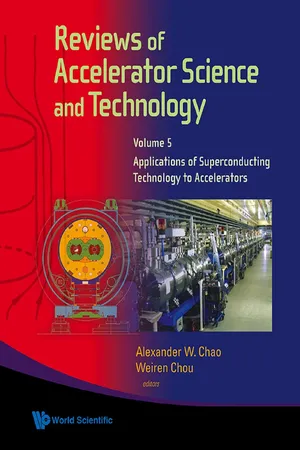
Reviews Of Accelerator Science And Technology - Volume 5: Applications Of Superconducting Technology To Accelerators
Volume 5: Applications of Superconducting Technology to Accelerators
- 368 pages
- English
- ePUB (mobile friendly)
- Available on iOS & Android
Reviews Of Accelerator Science And Technology - Volume 5: Applications Of Superconducting Technology To Accelerators
Volume 5: Applications of Superconducting Technology to Accelerators
About This Book
Over the past several decades major advances in accelerators have resulted from breakthroughs in accelerator science and accelerator technology. After the introduction of a new accelerator physics concept or the implementation of a new technology, a leap in accelerator performance followed. A well-known representation of these advances is the Livingston chart, which shows an exponential growth of accelerator performance over the last seven or eight decades. One of the breakthrough accelerator technologies that support this exponential growth is superconducting technology. Recognizing this major technological advance, we dedicate Volume 5 of Reviews of Accelerator Science and Technology (RAST) to superconducting technology and its applications.
Two major applications are superconducting magnets (SC magnets) and superconducting radio-frequency (SRF) cavities. SC magnets provide much higher magnetic field than their room-temperature counterparts, thus allowing accelerators to reach higher energies with comparable size as well as much reduced power consumption. SRF technology allows field energy storage for continuous wave applications and energy recovery, in addition to the advantage of tremendous power savings and better particle beam quality. In this volume, we describe both technologies and their applications. We also include discussion of the associated R&D in superconducting materials and the future prospects for these technologies.
Contents:
- Overview of Superconductivity and Challenges in Applications (Rene Flükiger)
- Superconducting Materials and Conductors: Fabrication and Limiting Parameters (Luca Bottura and Arno Godeke)
- Superconducting Magnets for Particle Accelerators (Lucio Rossi and Luca Bottura)
- Superconducting Magnets for Particle Detectors and Fusion Devices (Akira Yamamoto and Thomas Taylor)
- Superconducting Radio-Frequency Fundamentals for Particle Accelerators (Alex Gurevich)
- Superconducting Radio-Frequency Systems for High- β Particle Accelerators (Sergey Belomestnykh)
- Superconducting Radio-Frequency Cavities for Low-Beta Particle Accelerators (Michael Kelly)
- Cryogenic Technology for Superconducting Accelerators (Kenji Hosoyama)
- Superconductivity in Medicine (Jose R Alonso and Timothy A Antaya)
- Industrialization of Superconducting RF Accelerator Technology (Michael Peiniger, Michael Pekeler and Hanspeter Vogel)
- Superconducting Radio-Frequency Technology R&D for Future Accelerator Applications (Charles E Reece and Gianluigi Ciovati)
- Educating and Training Accelerator Scientists and Technologists for Tomorrow (William Barletta, Swapan Chattopadhyay and Andrei Seryi)
- Pursuit of Accelerator Projects at KEK in Japan (Yoshitaka Kimura and Nobukazu Toge)
Readership: Physicists and engineers in accelerator science and industry.
Frequently asked questions
Information








Table of contents
- Cover
- Title Page1
- Title Page2
- Copyright Page
- Table of content
- Editorial Preface
- chap1
- chap2
- chap3
- chap4
- chap5
- chap6
- chap7
- chap8
- chap9
- chap10
- chap11
- chap12
- chap13